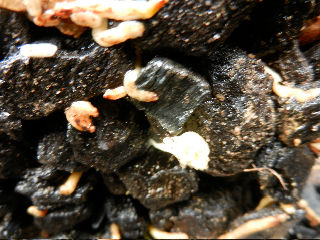Re-potting and Growth Test of Dendrobium Midas Touch D3
- Mark Daniels (strongrow.orchids@gmail.com)
- Jun 12, 2017
- 3 min read
The following procedure is a documented test using time and date to discover just how good Strongrow’s Orchid Mineral Growing Powder is. Introducing the famous Dendrobium Midas Touch D3 (acquired late 2014), the two times Ira Butler Trophy winner. The reason we are dividing and re-potting it is that it has been under significant stress after treatment for a bacterial infection, plus trying to get it established.

Fig. 1 - Dendrobium Midas Touch D3:

Fig. 2 - Den. Midas Touch D3 ready to go and I will now scrape the surface of the mix.

Fig. 3 - Close inspection reveals a non-aerated mix with signs of pathogens the plant has to compete with.

Fig. 4 - Further inspection tells us a story of a clogged up smooth non-absorbent components because of over fertilizing and watering. There are some pathogens lurking in the form of fungi. Algae are also beginning to take hold, together with black sooty mould (they exist in collaboration with each other). The white patch could be Mycelium fungi at an early stage. They are only at the development stage but if left longer, until next growing season more new growths would have been aborted too.

Fig. 5 - The plant has now been divided in two pieces, thoroughly dipped and washed around the base of the pseudobulbs without hurting the growth initiating eyes. Use 30 mls. of disinfectant and 30 mls. of dishwashing detergent to 30 litres of water.

Fig. 6 -The Strongrow Bush Orchid Mix is now ready to go after all fines have been sieved out. All components are of varying sizes. This was a discovery in the early years of Australian orchid growers. It was to help stop fungi and pathogens from getting established. They did not have many chemicals to choose from in those days so it was a way of preventing infection. The more uniform your mix the more chance you have of infections. This has been largely forgotten since the chemical spray revolution.

Fig. 7 - Roots all primed up with Orchid Mineral Growing Powder and the official time/date recorded to satisfy the sceptics.

Fig. 8 - The re-potting processes. Note how clean and dry our mix is for maximum nutrient intake and growth. Orchids absorb more nutrients when the moisture content is low rather than wet and damp all the time. Water your plants like in a rainstorm but not often and let it dry out (that's why orchids have pseudobulbs to help it harden up and get established). Once the root system is in place, you water when you feel dry and thirsty and not when you are cold and damp.

Fig. 9 - The orchid is now potted with the use a of rounded long thin steel rod to probe and make sure all voids are closed in, then tap your pot on something firm to loosen up the mix.

Fig. 10 - The plants are now placed in a moderated well lighted spot to wait a few days, before watering. This gives the powder time to do its job. I will then lightly water in carefully so as not to spill and waste the powder.

Fig. 11 - A good watering 3 times over two weeks will set off the mechanism for strong initial growth in 6 weeks to 3 months. If we re-potted in spring this would be clearly seen, however in autumn growth can be a little slower. I will let you all know the results in the future. Growth will depend on the weather and light and I expect to have a great result. They will be placed in the intermediate bush house with cover in roof for water control, no heating or fans - yes even over winter.

Fig. 12 - It would be nice to see this result for Midas touch D3 - Rhizome fungi growing in a healthy potting mix, after rain.






















Comments